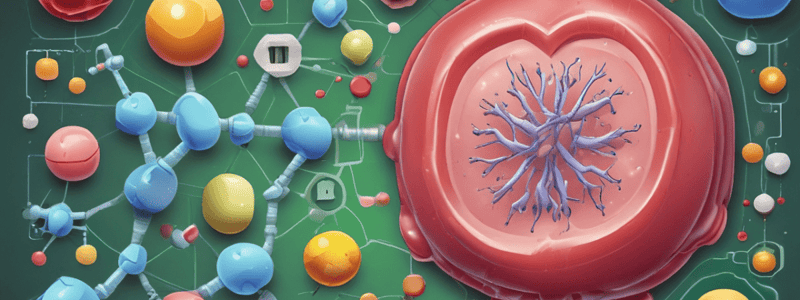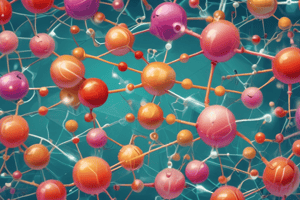Podcast
Questions and Answers
What is the desirable adult cholesterol level?
What is the desirable adult cholesterol level?
- 4.2 mmol/L
- 5.2 mmol/L (correct)
- 6.2 mmol/L
- 7.2 mmol/L
What is the classification of a triglyceride level of 300 mg/dL?
What is the classification of a triglyceride level of 300 mg/dL?
- High (correct)
- Mild
- Extremely high
- Very high
What is the preferred sample for lipid determination?
What is the preferred sample for lipid determination?
- Heparinized plasma
- Whole blood
- Serum (correct)
- EDTA plasma
What is the sensitivity of the cholesterol method?
What is the sensitivity of the cholesterol method?
What causes hypertriglyceridemia?
What causes hypertriglyceridemia?
What is the classification of a cholesterol level of 300 mg/dL?
What is the classification of a cholesterol level of 300 mg/dL?
What is the lipoprotein that is formed in the liver and carries endogenous triglycerides?
What is the lipoprotein that is formed in the liver and carries endogenous triglycerides?
What is the lipoprotein that is the major cholesterol carrier?
What is the lipoprotein that is the major cholesterol carrier?
Which fatty acid contains 12 carbon atoms?
Which fatty acid contains 12 carbon atoms?
Which type of fatty acid lowers the risk of cardiovascular disease?
Which type of fatty acid lowers the risk of cardiovascular disease?
Which is the rate-limiting enzyme in the biosynthesis of cholesterol?
Which is the rate-limiting enzyme in the biosynthesis of cholesterol?
Which is the major protein of HDL?
Which is the major protein of HDL?
Which lipoprotein are the major carriers of endogenous triglycerides?
Which lipoprotein are the major carriers of endogenous triglycerides?
Which specimen is most often used to determine total proteins?
Which specimen is most often used to determine total proteins?
Which factor can increase the test result of total protein determination?
Which factor can increase the test result of total protein determination?
On which assumption is the Kjedahl method of protein determination done?
On which assumption is the Kjedahl method of protein determination done?
What is the concentration of the standard used for the BUN sample?
What is the concentration of the standard used for the BUN sample?
What is the absorbance of the test in the BUA analysis?
What is the absorbance of the test in the BUA analysis?
What is the absorbance of the standard in the creatinine analysis?
What is the absorbance of the standard in the creatinine analysis?
What is the concentration of the standard used in the glucose analysis?
What is the concentration of the standard used in the glucose analysis?
What is the interval between the two readings in the BUN sample analysis?
What is the interval between the two readings in the BUN sample analysis?
Which actions are associated with the hormone insulin?
Which actions are associated with the hormone insulin?
What is a characteristic of hyperglycemia?
What is a characteristic of hyperglycemia?
What is the absorbance of the test in the glucose analysis?
What is the absorbance of the test in the glucose analysis?
What is a feature of Type I diabetes mellitus?
What is a feature of Type I diabetes mellitus?
What is the result that indicates impaired glucose tolerance?
What is the result that indicates impaired glucose tolerance?
What is one of the criteria used to diagnose diabetes mellitus?
What is one of the criteria used to diagnose diabetes mellitus?
Which of the following is true about blood glucose measurement?
Which of the following is true about blood glucose measurement?
What is a characteristic of Von-Gierke disease?
What is a characteristic of Von-Gierke disease?
How would you compute for the serum triglyceride of an adult patient?
How would you compute for the serum triglyceride of an adult patient?
When is the best time to collect a sample for fasting blood glucose?
When is the best time to collect a sample for fasting blood glucose?
Which enzyme is most specific for β-D-glucose in blood glucose determination?
Which enzyme is most specific for β-D-glucose in blood glucose determination?
How would you interpret the cholesterol result after determining the correct level of total cholesterol?
How would you interpret the cholesterol result after determining the correct level of total cholesterol?
Which glucose method is prone to falsely low results due to uric acid?
Which glucose method is prone to falsely low results due to uric acid?
Which enzyme is used as the coupling enzyme in the Hexokinase method of glucose determination?
Which enzyme is used as the coupling enzyme in the Hexokinase method of glucose determination?
Which method is currently considered the best for measuring blood glucose?
Which method is currently considered the best for measuring blood glucose?
What is the purpose of mutarotase in blood glucose measurement?
What is the purpose of mutarotase in blood glucose measurement?
Which patients are more prone to developing hyperosmolar, ketotic states?
Which patients are more prone to developing hyperosmolar, ketotic states?
Study Notes
Clinical Chemistry 1
Quiz 4
- Fatty acids:
- Fatty acid with 12 carbon atoms is a medium-chain fatty acid
- Unsaturated fatty acids lower the risk of cardiovascular disease
- Cholesterol biosynthesis:
- HMG-CoA reductase is the rate-limiting enzyme
- Lipoproteins:
- HDL is the major protein of HDL
- Apo A-I is exclusively found in chylomicrons
- VLDL is the major carrier of endogenous triglycerides
- Protein determination:
- Total protein levels can be affected by lipemia, hemolysis, and dehydration
- Plasma is the most common specimen used to determine total proteins
- Lipid profile:
- LDL cholesterol is the major cholesterol carrier
- HDL is also known as good cholesterol
- VLDL is formed in the liver and carries endogenous triglycerides
Case A
- Compute for the serum HDL cholesterol using the given absorbance and concentration values
Case B
- Compute for the serum triglyceride level using the given absorbance and concentration values
Quiz 3
Insulin and Glucose Metabolism
- Insulin actions:
- Increases glycolysis
- Increases glycogenesis
- Decreases gluconeogenesis
- Hyperglycemia:
- Increased glucose in plasma and urine
- Increased urine specific gravity
- Presence of urine ketones
Diabetes Mellitus
- Type I diabetes mellitus:
- Tendency for ketosis
- Low or no insulin level
- Presence of autoantibodies
- Diagnosis of diabetes mellitus:
- HbA1c of ≥ 6.5%
- FPG of ≥ 126 mg/dL
- 2-hr OGTT ≥ 200 mg/dL
Glucose Measurement
- Blood glucose measurement:
- Sample can be serum, plasma, or whole blood
- Whole blood glucose is lower than in plasma
- Serum or plasma must be separated within 1 hour
- Fluoride inhibits glycolytic enzymes
- Enzymes in glucose determination:
- Hexokinase is specific for β-D-glucose
- Glucose oxidase is specific for glucose
- Mutarotase converts α to β-D-glucose
Studying That Suits You
Use AI to generate personalized quizzes and flashcards to suit your learning preferences.
Related Documents
Description
Review questions for Clinical Chemistry 1, covering fatty acids and cholesterol biosynthesis. Topics include fatty acid classification, cardiovascular health, and enzyme regulation.




